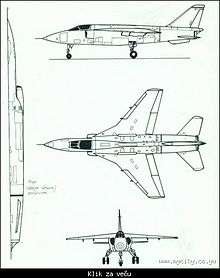Soko J-22 Orao
| J-22 Orao | |
|---|---|
 | |
| A Serbian Air Force J-22 Orao of the 241st Fighter-Bomber Aviation Squadron. | |
| Role | Attack aircraft Reconnaissance aircraft |
| Manufacturer | SOKO |
| Designer | VTI - Yugoslavia INCAS - Romania |
| First flight | November 1974 |
| Introduction | 1978 |
| Status | Active |
| Primary users | Yugoslav Air Force Serbian Air Force Bosnian Air Force |
| Variants | Avioane Craiova IAR-93 Vultur |
The Soko J-22 Orao (English: Eagle) is a Yugoslav twin-engined, subsonic ground-attack and reconnaissance aircraft. It was designed as a single-seat main attack version or as a combat capable two-seat version for advanced flying and weapon training. It was developed as a joint Yugoslav-Romanian project in the 1970s for the air forces of both nations, SOKO built it in Yugoslavia, and Avioane Craiova built it as the IAR-93 Vultur in Romania.
Development

On 20 May 1971, the governments of Romania and Yugoslavia signed an agreement for the formation of YuRom, a joint R&D venture. The program was headed by Dipl. Dr. Engineer Teodor Zanfirescu of Romania and Colonel Vidoje Knezević of Yugoslavia. The aircraft was intended as a replacement for the lightly armed Soko J-21 Jastreb and the Republic F-84 Thunderjet, then in the JNA arsenal.
The requirements called for a light aircraft to be built on a simple structure, using locally produced equipment and avionics, tough (able to operate on grass or damaged runways), easy to maintain and reliable. The aircraft was of conventional twin-engine, high mounted wing monoplane configuration with all flying surfaces swept. The designers originally planned a single-engined supersonic aircraft, but Britain would not authorize the license for the engine the designers wanted (due to Romania being in the Warsaw Pact), so the less-powerful Rolls-Royce Viper was chosen as the powerplant, as Soko had experience with license-building this engine. It was originally intended that an afterburner would be developed for the Viper engines, but there were prolonged difficulties with this project, meaning that none of the pre-production aircraft featured it, and neither did early production examples. During the 1980s, both countries developed slightly different versions to take advantage of the afterburning engines that had since become available.
The Yugoslav prototype 25002 made its first flight in November 1974 from Batajnica Air Base near Belgrade, with Major Vladislav Slavujević at the controls.
The third aircraft, numbered 003, a pre-production two-seater version, made its first flight on 4 July 1977, but was lost almost a year later due to tail flutter problems. Construction continued, and the first batches of pre-production machines were delivered in 1978 to the Air Force Aircraft Testing Facility in Belgrade, with serial production being set up in Mostar, Bosnia and Herzegovina.
On 22 November 1984, Orao 25101 piloted by test pilot Marjan Jelen broke the sound barrier in a shallow dive over Batajnica Air Base, becoming the first Yugoslav-designed aircraft to exceed Mach 1. The aircraft is incapable of breaking the sound barrier in level flight, so it is classified as subsonic.
Design

The J-22 is a twin-engined combat jet aircraft for close air support, ground attack and tactical reconnaissance warplane with limited air-defense capability.
Standard communication and navigation equipment, plus (fire control and weapons management) Thompson-CSF VE-120T HUD replacing the original Ferranti ISIS D-282 gyro sight (defensive sensors and systems) Iskra SO-1 RWR and provision for up to three chaff/flare dispensers and P10-65-13 passive jammer pod, and (navigation) Honeywell SGP500 twin-gyro platform; there is also provision for an optical/IR reconnaissance pod or an optical reconnaissance/jammer pod.
Operational history

The first Yugoslav Air Force unit which received J-22 aircraft was the 351st (reconnaissance aviation squadron) from 82nd Aviation Brigade, Cerklje. Until the 1991 war, there were only three squadrons fully equipped with J-22 attack aircraft and NJ-22 trainer-attack aircraft. Those units were the 238th (fighter-bomber aviation squadron) from 82nd Aviation Brigade, 241st and 98nd Aviation Brigade and 242nd and 127th Fighter-Bomber Regiment, Golubovci Airbase. There were also about three squadrons partly equipped with J-22 aircraft.
At the beginning of the Yugoslav wars, in Slovenia, J-22s flew over in a show of force, but did not drop any bombs. The first offensive action by the J-22 was in 1991 when the Yugoslav National Army used them to strike targets in Croatia. During the first year of war three J-22s were shot down, NJ-22 flown by Lieutenant Colonel Muse Begić who ejected safely and a J-22 flown by Major Z.Tomić (KIA) from the 238th. After the withdrawal of the JNA from Slovenia, the 82nd Aviation Brigade was relocated from Cerklje to Banja Luka Mahovljani air base. In 1992 when the Bosnian war started, the JNA left a single squadron of eight J-22s to the Republika Srpska Air Force. One J-22 was lost during the war.
In 1999, Yugoslav J-22s saw limited combat against the KLA flying 20 combat missions. One J-22, piloted by Lt. Colonel Života Ðurić was lost on 25 March 1999 in unclear circumstances, either through malfunction, pilot error or KLA ground fire. In addition, 11 aircraft were destroyed on the ground, most at Ponikve airbase when a NATO air strike hit one hangar with six J-22 and two MiG-21 aircraft.
On June 3, 2010, a Serbian Air Force J-22, piloted by Major Slobodan Jocić, crashed in central Serbia. The aircraft's landing gear malfunctioned, forcing the pilot to direct the aircraft into a lake and eject. The pilot was safely rescued soon after the incident.[1]
Variants
- IJ-22 Orao 1
- Designation applies to 15 Yugoslav-built pre-production aircraft (including a few completed to INJ-22A Orao two-seat standard) with the non-afterburning powerplant and used for the tactical reconnaissance role with a centerline optical and/or IR sensor pod. The IJ-22A Orao 1 differs from the J-22B Orao 2 in having two Viper Mk 632-41R turbojets each rated at 17.79 kN dry and supplied with fuel from an internal weight of 2,360 kg, length of 14.90 m including probe for single seat model or 15.38 m including probe for two-seat model, wheelbase of 5.40 m for single-seat model or 5.88 m for two-seat model, empty equipped weight of 5,755 kg, normal takeoff weight of 8,500 kg with reconnaissance pod, maximum take-off weight of 9500, maximum level speed ‘clean’ of 1,033 km/h at 8,000 m and 1,050 km/h at sea level, maximum rate of climb at sea level of 2,280 m per minute, climb to 6000 m in 3 minutes 12 seconds, and service ceiling of 13,500 m.
- J-22A Orao 1
- Yugoslav equivalent to IAR-93A with a non-afterburning Orao/Turbomecanica (Rolls-Royce/Bristol Siddeley) Viper Mk 632-41R turbojets each rated at 17.79 kN dry, but with J-22Bs higher-rated hardpoints. First flew October 1983 and built only as a single-seater.
- J-22B Orao 2
- Yugoslav equivalent to the IAR-93B with afterburner, integral wing tankage, the greater weapons load and diversity of the J-22A Orao 1, and Thomson-CSF HUD. Built only in single-seat form. J-22A/B production will total 165 aircraft. Yugoslavia had planned a major upgrade with radar and computer nav/attack system integrated via a MIL 1553B digital database, but the dissolution of Yugoslavia ended plans.
- NJ-22 Orao
- Dedicated two-seat reconnaissance variant operated by Yugoslav Air Force with provision for an optical/IR sensor pod on centerline. First flew July 1986, and 35 were delivered in NJ-22A Orao 1 and NJ-22B Orao 2 forms with non-afterburning and afterburning powerplants respectively.
Operators
-
 Bosnia and Herzegovina – Inherited 7 from the Republika Srpska Air Force.[2]
Bosnia and Herzegovina – Inherited 7 from the Republika Srpska Air Force.[2] -
 Serbia – Serbian Air Force currently operates 26 J-22s. Fleet consists of 9 J-22, 7 NJ-22, 8 IJ-22 and 2 INJ-22. IJ/INJ-22 have not flown since 2003. No more than 6 J-22/NJ-22 are operational at any time.[3]
Serbia – Serbian Air Force currently operates 26 J-22s. Fleet consists of 9 J-22, 7 NJ-22, 8 IJ-22 and 2 INJ-22. IJ/INJ-22 have not flown since 2003. No more than 6 J-22/NJ-22 are operational at any time.[3] -
 Yugoslavia – Passed on to successor states.
Yugoslavia – Passed on to successor states.
Specifications (J-22)

Data from Jane's All The World's Aircraft 1993-94[4]
General characteristics
- Crew: one or two,pilot
- Length: 13.02 m (42 ft 8½ in)
- Wingspan: 9.30 m (30 ft 6¼ in)
- Height: 4.52 m (14 ft 10 in)
- Wing area: 26.00 m² (279.9 ft²)
- Empty weight: 5,550 kg (12,125 lb)
- Max. takeoff weight: 11,080 kg (24,427 lb)
- Powerplant: 2 × Orao/Turbomecanica-built Rolls-Royce Viper Mk 633-41 turbojet
- Dry thrust: 17.79 kN (4,000 lbf) each
- Thrust with afterburner: 22.24 kN (5,000 lbf) each
Performance
- Maximum speed: 1,130 km/h (610 knots, 702 mph) at sea level
- Stall speed: 185 km/h (100 knots, 115 mph)
- Combat radius: 522 km (282 nmi, 324 mi) (four BL755 cluster bombs and one 1,500 L drop tank)
- Ferry range: 1,320 km, 820 mi, 713 nmi ()
- Service ceiling: 15,000 m (49,210 ft)
- Rate of climb: 89 m/s (17,520 ft/min)
Armament
- Guns: 2 × 23 mm GSh-23L cannons
- Hardpoints: Five (four underwing and one centreline) with a capacity of 500 kg (1,100 lb) (wing pylons), 800 kg (1,770 lb) (centreline pylons) - total capacity 2,800 kg (6,200 lb)
- Missiles: AGM-65 Maverick TV guided AGM or Grom-1 Radio-guided AGM (based on Soviet Kh-23).
- Bombs: MK series bombs, BL755 cluster bombs, Matra Durandal anti-runaway bombs,and laser guided bombs.
See also
- Related development
- Aircraft of comparable role, configuration and era
References
- Notes
- ↑ ""Orao" pao u Gružansko jezero" (in Serbian). Politika. 18 November 2010. Retrieved 25 August 2011.
- ↑ "Serbia eyes surplus Bosnian fighters". Flightglobal.com. 25 September 2008. Retrieved 23 April 2013.
- ↑ http://tangosix.rs/2016/06/04/orao/
- ↑ Lambert 1993, pp. 179–181.
- Bibliography
- Gunston, Bill. The Encyclopedia of Modern Warplanes: The Development and Specifications of All Active Military Aircraft. New York: MetroBooks, 1995. ISBN 1-58663-207-8.
- Gunston, Bill. Encyclopedia Of World Air Power. London: Crescent, 1987. ISBN 0-517-49969-X.
- Lambert, Mark (ed.). Jane's All The World's Aircraft 1993-94. Coulsdon, UK: Jane's Data Division, 1993. ISBN 0-7106-1066-1.
External links
| Wikimedia Commons has media related to Soko J-22 Orao. |
- Serbian Air Force entry at World Air Forces website
- AIRSERBIA - Serbian Aeronautical Information Network
- Soko J-22 Orao at Airliners.net
- Photos at Avioni.net: Orao in low level flight at Kecskemet airshow in 2005, also here: at Batajnica airport, and here: at Batajnica.
- Photo at ABG (Avijacija Bez Granica): Orao NJ-22 in flight 1980s